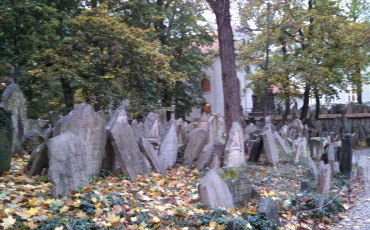A Ghost Story

In early November of 2014, I visited Prague with a friend of mine whose parents were born in Prague, Czechoslovakia, and lived through World War II, emigrating to the U.S. after the war. My friend's mother’s dearest high school friend, Renata Perutz, was Jewish and was imprisoned in Theresienstadt concentration camp and died, a victim of the Nazi holocaust.
In Prague we visited the Pinkas Synagogue which was turned into a memorial to the holocaust. Inside the memorial, on tall white walls are written the names and dates of birth and death, in black and red letters, of the nearly 80,000 Jewish Czech victims of the holocaust. The dates of death are only estimates based on when these many souls were taken to one of the Nazi death camps. These names fill several rooms - there are far too many for one room and are grouped by the towns where the victims had lived. These white walls are the mass ‘graves’ of these souls - memorialized so that they might not be forgotten. On the high white walls of the main part of the synagogue/memorial are the names of the victims from Prague. My friend’s mother’s friend and her family are listed among the dead from Prague, visible in the photo below.
In another part of the museum are two rooms exhibiting children’s drawings from the Ghetto Theresienstadt. The children of Theresienstadt were entertained, distracted and enriched by art classes taught by the artist Friedl Dicker-Brandeis. The art the children of Theresienstadt created survived in hidden suitcases but the children did not. Most died in the gas chambers of the death camps of Auschwitz-Birkenau. The Holocaust Museum in Prague honors these children in rooms dimmed to protect the artwork which depict life in the Ghetto, planes, blood, sadness and are wrenching to absorb. Observing these drawings preserved inside glass cases is a holy devotion, like visiting a graveyard, honoring the life of each child whose adult life was denied and whose last years of childhood consisted of unspeakable horror. It was in front of one of the glass cases, where I was gazing at the work of one of these tormented children, when I became aware of a teen-aged girl behind me, looking over my left shoulder into the same glass case. I could clearly see her reflection in the glass. She was tall enough for me to see her head fully over my shoulder and her dark brown hair was just below her chin with a clean wave that turned it under, framing her face. When I turned around to see her, there was no one there. I brushed it off as some sort of mental or visual trickery and turned back to the glass case and its artwork. After a few moments, the girl returned. Again, I turned to see her and again, no one was there. She was there for those moments, this teen-age spirit, perhaps the spirit of one of the artists, perhaps the artist whose work I was observing, perhaps Renata Perutz, my friend’s mother’s friend.
We are taught to run screaming from a ghost, a spirit, an unexplained presence and I have never before had occasion to encounter, or run from or stand in close proximity to a ghost or spirit. And yet, in the presence of this young woman/spirit/ghost, I felt no fear, nor was I perturbed by her presence. Also, I didn’t think of her as a ghost or a threat or a mystery. She just was there and that was it. She existed like any other person you might see over your shoulder. I saw her clearly, twice, and perhaps, if she was a spirit of one of these tortured children, her wish is to exist, to exist in someone’s mind, in someone’s heart and to not be forgotten. My mind accepted her as a perfectly logical companion in this holy place and when I walked away, I held her in my heart calmly and with compassion. My friend had been in the other room of children’s drawings and I asked her if she had encountered anyone but no, she had not. So here, even if you think this is crazy or weird, I attest to this young woman’s presence. For me, she exists. She is held in my heart with compassion and will not be forgotten. And now, I have planted her in your memory and perhaps you will remember her and tell your children about her, and she will, in this way, have a present and a future that the Nazis worked so hard to destroy.

To leave a comment, please Signin or Register.